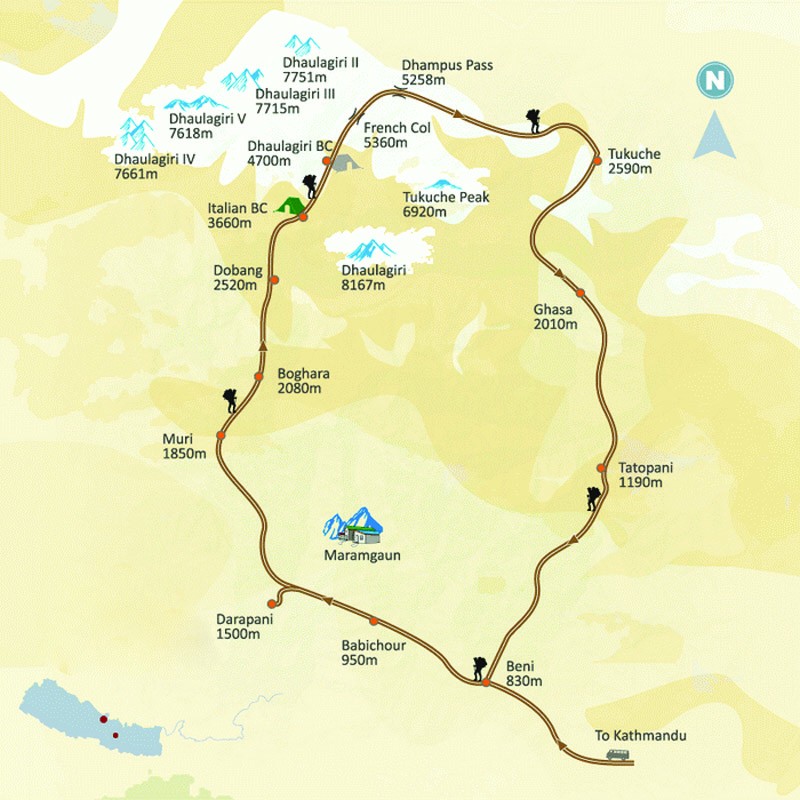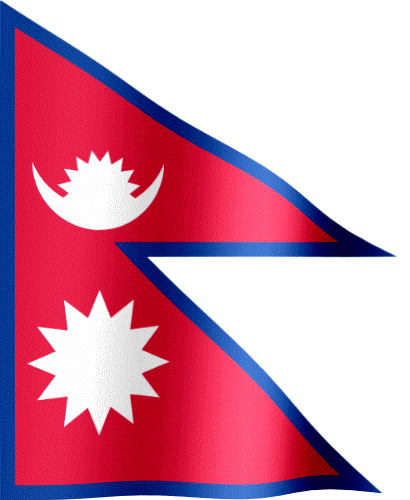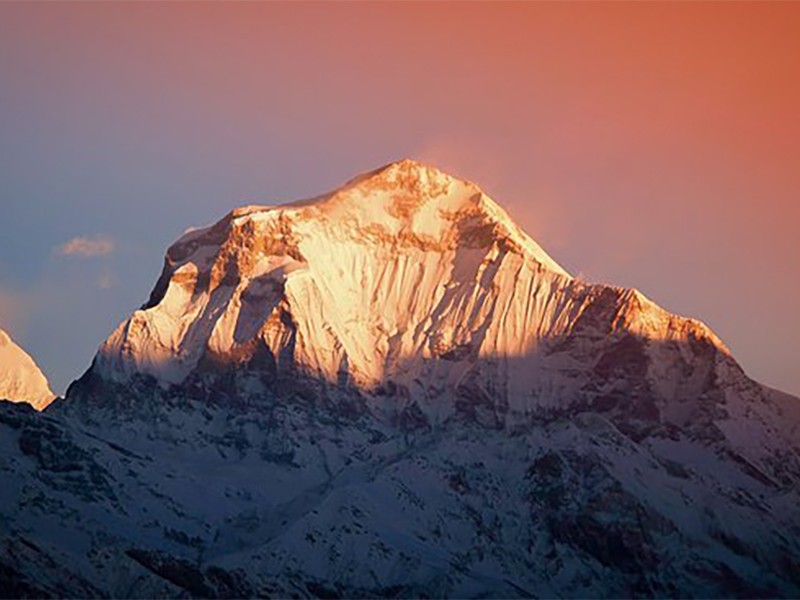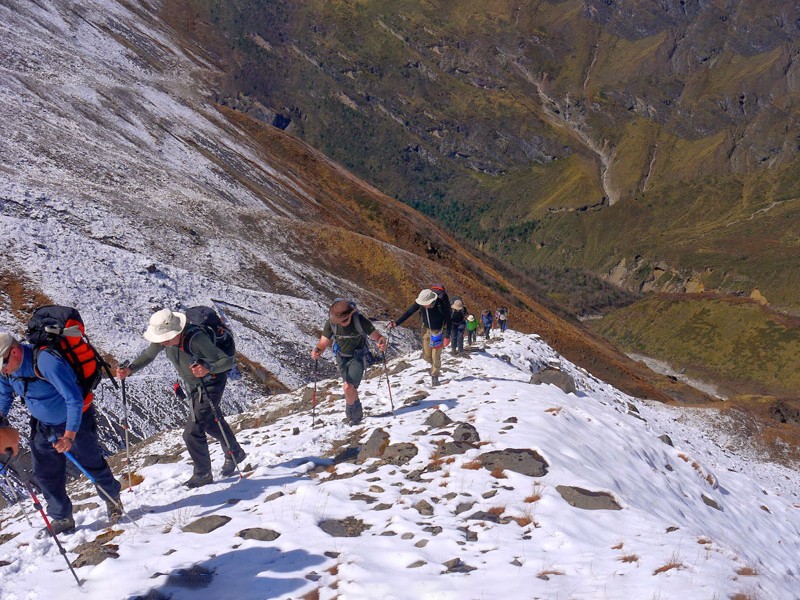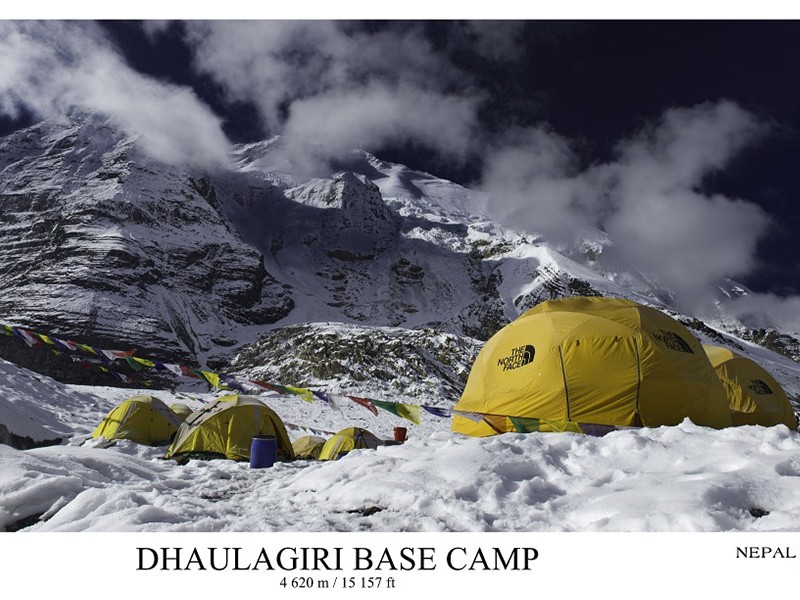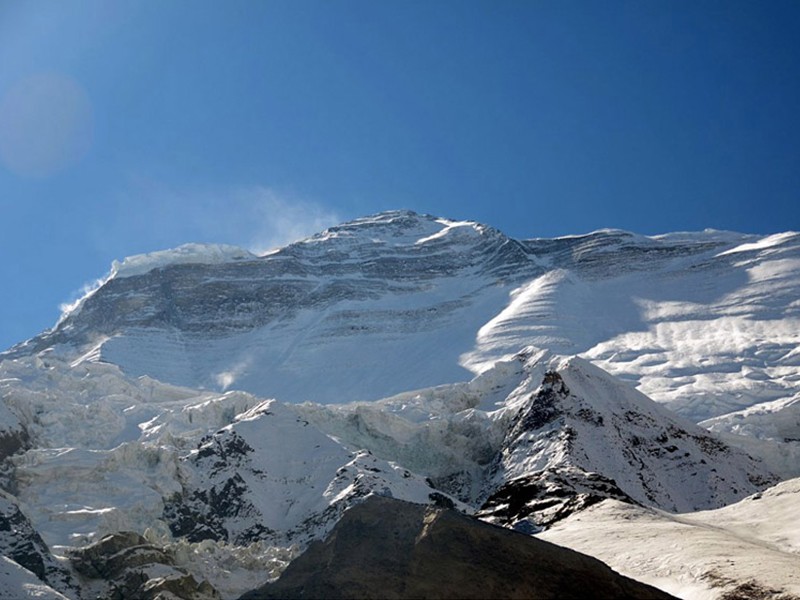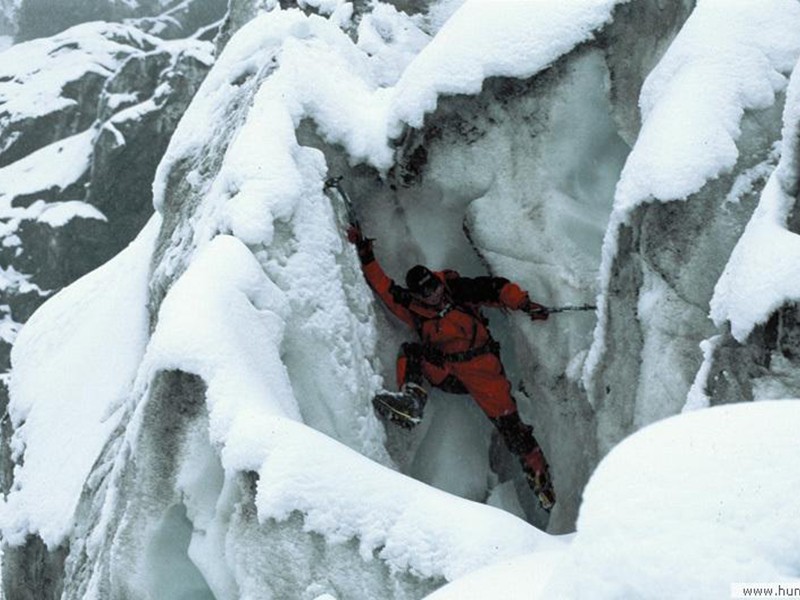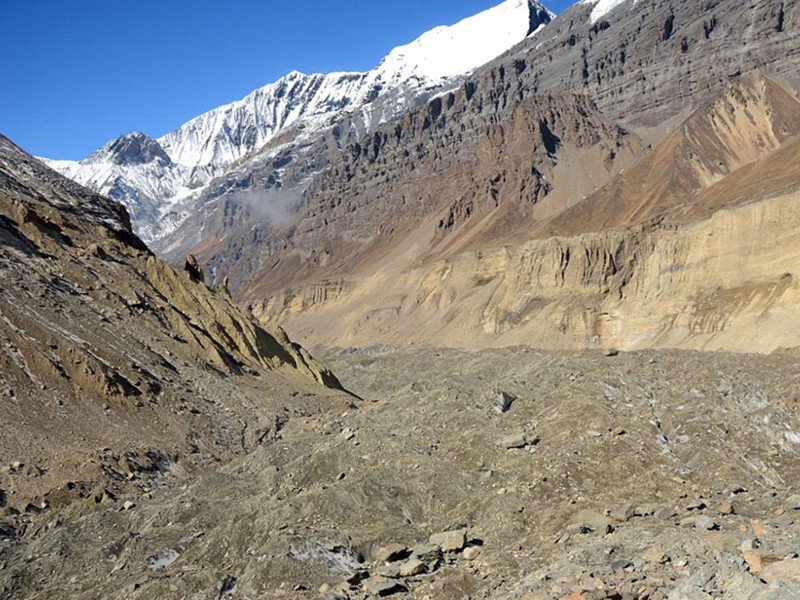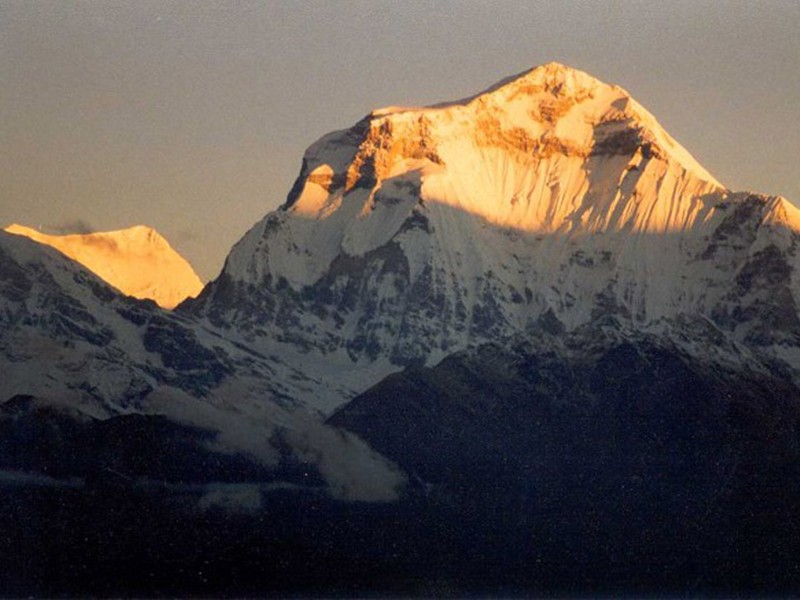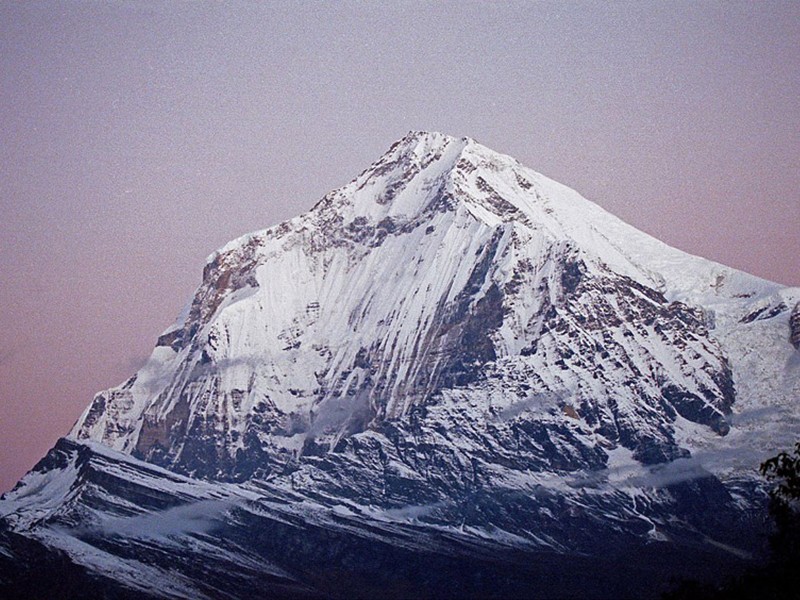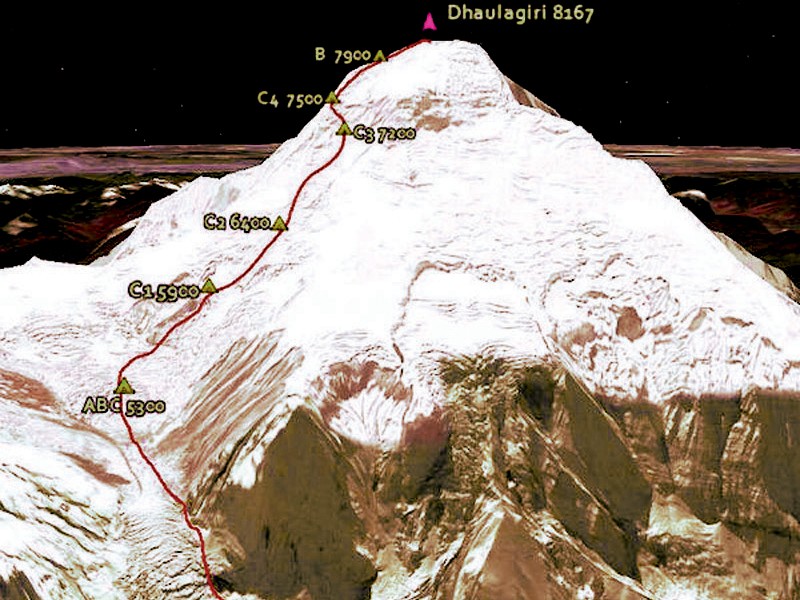Reference Code: MDEPNP
Trip Start: Kathmandu
Trek Start: Beni
Trek Days: 42 days
Peak Climbing Period: 26 days
Maximum Altitude: 8167m.
Age: 25-60 years
Season: Spring and Autumn
Accommodation: Camp
Service: Full Board
Destination: Nepal
Trip End: Kathmandu
Trek End: Jomsom
Trip Durations: 48 days
Peak Grade: Extreme
Physical Rating: Strenuous
Group Size: 2-10
Theme: Expedition
Meals: Standard
Mount Dhaulagiri is the seventh highest mountain in the world. It is an enormous Himalayan massif, located in north central Nepal. It is the highest mountain located entirely within Nepal. Dhaulagiri’ s crest stretches for thirty miles, lending structure to an otherwise tangled topography of twisting ridges, glaciers, and ice falls. Along the main crest, several pyramid-shaped peaks rise. Four of these summits, numbered from east to west, rise above 25,000 feet. Our expedition is an attempt on the highest of these four peaks, climbing Dhaulagiri I.
The first successful Dhaulagiri expedition was in 1960 when Kurt Diemberger, Peter Diener, Ernst Forrer, Albin Schelbert, Nyima Dorji and Nawang Dorji, members of a Swiss/Austrian expedition climbed it.
The Dhaulagiri Expedition lasts almost 7 weeks including a weeklong trek to the basecamp at 4750 metres. Although there are multiple routes up it, Dhaulagiri is a difficult mountain and a technical climb regardless of the route requiring a high level of skill. The standard route for climbing Dhaulagiri is via the North East Ridge and is climbed with 3 camps above basecamp.
Day 01 Arrival in Kathmandu 1350m.
Namaste! And welcome to Kathmandu, the colourful capital of Nepal where ornately carved balconies mingle with beautiful shrines and temples. Your adventure begins with a welcome meeting on arrival at the exit gate of Kathmandu airport. Our staff will welcome you and pick you to your accommodated hotel. Please seek our company palmplate to find our staff at the main exit gate of the airport. Rest of the day you can relax at the hotel or short evening walk around local market on your own as per your wish.
Approximate Driving Hours: 30 minutes
Accommodation: Hotel
Meals include: None
Day 02 Rest and preparation day
A well deserved rest day at cosy of hotel after a long tiring flight. This day, one can move around nearby local market to purchase or hire trekking equipment that is necessary for the trekking like sleeping bags, walking sticks etc, exchange currency as requirement or simply walk around in the local market or Kathmandu Durbar squire nearby with small entrance fee as per your preference on your own. Evening at the hotel lobby there will be pre-trip briefing in which you will be introduced with your trekking guide and explained about your trip in short, instruction for safety etc.
Accommodation: Hotel
Meals include: Breakfast
Day 03 Official works and Pre trip briefing by officers of Ministry of Tourism
Day is at leisure to make necessary preparation for your big adventure and process for the Government formalities. Check the equipment, last minute shopping. Team will need to go to Ministry of Tourism for the Briefing before expedition.
Accommodation: Hotel
Meals include: Breakfast
Day 04 Fly to Pokhara 820m.
After Breakfast, depending on the flight timings, you are trasnferred to Domestic airport for your flight to Pokhara. Upon reaching Pokhara you are then trasnferred to Hotel where remaining day is at leisure. On your leisure, you can stroll around the lake side area.
Flight time:
Driving hours:
Accommodation: Hotel
Meals include: Breakfast
Day 05 Drive to Beni 830m. and then to Shibang 1780m
Early breakfast at the hotel. Today we have a long hour drive on a curving mountain off road drive. The roaring Kali Gandaki river is followed to Beni and further to Sibang.
Driving Hours: 8 to10 hrs Mountain Ride
Altitude gain/loss:
Accommodation: Camp
Meals include: Breakfast, Lunch and Dinner
Day 06 Trek to Muri 1850m
First day of walk, after breakfast, we start our walk from Shibang following the deeply buried canyon of the Myagdi River over imposing suspension bridges and airy stairs up to the Magar Village, Muri. On a clear day, you can have a majestic view of Dhaulagiri massif on the horizon.
Altitude gain/loss: Ascend:600m/Descend:100m
Walking Hour: 5 hours
Accommodation: Camp
Meals: Breakfast Lunch and Dinner
Day 07 Trek to Boghara 2080m
Today, we walk through the green hilly landscape and partly dense jungle to Boghara. Enroute enjoy the view of the long chain of the white snow-covered Dhaulagiri Himal.
Altitude gain/loss: Ascend: 700m/Descend:600m
Walking Hour: 4-5 hours
Accommodation: Camp
Meals: Breakfast Lunch and Dinner
Day 08 Trek to Doban Kharka 2520m
This day, we follow the Myagdi Khola up the valley until we reach Dobang. We will pass through the primeval rainforest and a waterfall almost 70 m high is a highlight of todays walk.
Altitude gain/loss: Ascend: 800m/Descend: 200m
Walking Hour: 5-6 hours
Accommodation: Camp
Meals: Breakfast Lunch and Dinner
Day 09 Trek to Jungle Camp 3100m
We continue climbing through dense, impressive rainforest. You can see hundreds of parasite plants grow over the mighty trunks and dense treetops of the fir and pine trees. Some river crossings on shaky wooden bridges can be mastered over the foaming Myagdi Khola. We will halt for todays overnight at Jungle Camp.
Altitude gain/loss: Ascend: 700m/Descend: 100m
Walking Hour: 5 hours
Accommodation: Camp
Meals: Breakfast Lunch and Dinner
Day 10 Trek to Italian Basecamp 3660m.
From Jungle Camp we head towards the Italian Base Camp. We will be trekking initally on moraine and then enter the forest area with a picturesque bamboo jungle. Today we have a wonderful view of Tsaurabong Peak (6395m) and the imposing west wall of Dhaulagiri I, which rises just above us.
Altitude gain/loss: Ascend: 650m/Descend: 100m
Walking Hour: 5 hours
Accommodation: Camp
Meals: Breakfast Lunch and Dinner
Day 11 Trek to Dhaulagiri Base Camp 4750m.
This day will be a long walk from Italian Base camp to Dhaulagiri BC, passing through Japanese BC. From Italian BC the trail crossses a rocky area, traversing a steep slope and climbing abruptly to cross the glacier moraine. From Japanese BC, we follow the northside of the glacier sometimes walking on the lateral moraine and undulating glacier surface; we finally reach Dhaulagiri Base Camp 4750m.
From the Camp, you can have a majestic views of Dhaulagiri range – I / II / III / IV and Tukuche Peak.
Altitude gain/loss: Ascend: 950m
Walking Hour: 7-8 hours
Accommodation: Camp
Meals: Breakfast Lunch and Dinner
Day 12 Rest Day in Base Camp
Rest day at the base camp after a long walk. Afternoon check all your climbing equipments
Accommodation: Camp
Meals: Breakfast Lunch and Dinner
Day 13-14 In Base Camp – Puja Preparation
Ceremonies mark life. Many come with a birth of a child, a union of a couple or upon death. For the Sherpa, they will not climb mountains without one such ceremony, a Puja. Every sherpa people have a strong belief that each and every mountains abodes realm of gods and goddesses.
The Puja is an important ceremony where we pay respect to the mountain and offer blessings for safe passage before heading up onto Mountain.
Our Puja consisted of a Lama (Monk) and our entire crew participating in prayers, rice and flour throwing, and 3 sips of strong whiskey (just to name a few things from our 3-hour ceremony!). The stupa will be covered in beautiful decorations and sculptures made out of butter and tsampa, with plates full of food and drinks as offerings. It was incredible to witness and to be a part of.
Accommodation: Camp
Meals: Breakfast Lunch and Dinner
Day 15-39 Climbing Period for Mt. Dhaulagiri 8172m.
We do forth and back to our various camps on the mountain to fit our body with high altitude and weather we face during the actual climbing. On the day of the summit, we walk early mid night from our final high camp so that we can reach the summit as early morning as possible so that we do get good weather to return too. As the day gets older, the weather in mountain starts to get voilent and we no one wants to be in mercy of the mountain. The time and the oxygen in our oxygen cylinder is very crucial on the day as summit is just the half way of our success. If any things gets serious(time, body fitness, Oxygen level...), there will always be next time if we live and it will be very wise decision to return back for the next day. After summit we will return back to our base camp.
Accommodation: Camp
Meals: Breakfast Lunch and Dinner; high altitude food during climb
Day 40 Cleaning base camp
Its cruicial to clean up our base camp so that mountain remain clean. We clean our litter and pack up our equipment for move next day.
Accommodation: Camp
Meals: Breakfast Lunch and Dinner
Day 41 Trek to Hidden Valley 5140m. by crossing French Pass 5360m.
From base camp, we walk towards Hidden Valley. We climb steep hillside above the glacier with zig-zag trail across thee scree and moraine which leads up to French Pass. From the top you can have a 360 degree panorama of surrounding Mountain ranges. From the pass we descend down to Hidden Valley.
Altitude gain/loss: Ascend:800m/Elevation Descend: 400m
Walking Hour: 6 hours
Accommodation: Camp
Meals: Breakfast Lunch and Dinner
Day 42 Trek to Alu Bari 3900m. by crossing Dhampus Pass 5244m.
From Hidden valley, the trail begins with a short climb of Dhampus Pass, having a wonderful panorama of the Annapurna massif and the nilgiri sector. We then follow a high level alpine style traverse descending towards the Kaligandaki valley and camp at Alu Bari.
Altitude gain/loss: Ascend:500m/Elevation Descend: 1700m
Walking Hour: 7 hours
Accommodation: Camp
Meals: Breakfast Lunch and Dinner
Day 43 Trek to Marpha 2670m. and drive to Jomsom 2720m.
After a month, we finally see the human settlement at Marpha. This is a gem village with whitewashed houses, stone paved streets. From Marpha we take a local bus/jeep to Jomsom.
Altitude gain/loss: Ascend:60m/Elevation Descend: 1200m
Walking Hour: 3 hours Driving hours: 1.5 hours
Accommodation: Lodge
Meals: Breakfast Lunch and Dinner
Day 44 Fly to Pokhara 820m.
Take an early morning flight to Pokhara (approximately 20 minutes). Pokhara is a peaceful lakeside location which rests beneath the snow-capped peaks of the Annapurna Range. Pokhara is part of a once vibrant trade route extending between India and Tibet. This is the land of Magars and Gurungs, hardworking farmers and valorous warriors who have earned worldwide fame as Gurkha soldiers. The Thakalis, another important ethnic group here, are known for their entrepreneurship. Take time to wander around the town and get to know its friendly residents. You might like to sip on a cold brew and gaze up at the dramatic pass that you have just conquered. There are plenty of lakeside cafes where you can enjoy international cuisine, while the main street is full of shops and stalls selling a wide range of Nepali and Tibetan souvenirs. Your simple hotel in Pokhara is set 100 m back from Phewa Lake and with a back-drop of Machhapuchhare rising beyond. It has twin-bedded rooms with attached bath and hot shower facilities
Altitude gain/loss:
Flight Hour: 20 minutes Driving hours: 30min
Accommodation: Hotel
Meals: Breakfast
Day 45 Exploration day in Pokhara
Enjoy a free day in Pokhara to unwind, relax, and give those muscles a rest after all that trekking. Your leader can advise you of sightseeing opportunities. It is worth taking a boat for a row out on the lake, especially if the weather's fine. The lakeside area has great shopping and cafes. Pokhara has an interesting old area as well as an elaborate Hindu temple and a Buddhist monastery. Perhaps visit the Peace Pagoda, where spectacular views of the mountains await. You can see the Annapurnas from here, and the famous fishtail peak, Machhapuchhare, and back across to Pokhara. You can also visit the fascinating International Mountain Museum to learn some amazing tales of past climbing expeditions.
Accommodation: Hotel
Meals: Breakfast
Day 46 Fly to Kathmandu 1350m.
Weather permitting we take a short early morning flight from Pokhara to Kathmandu on day. We'll return to the hotel and have free time during the afternoon for further sightseeing or shopping. Shop in some of Kathmandu's many markets for clothing, embroidery, carpets or ceramics. If shopping is not your thing, take a trip over the Bagmati River to the adjacent city of Patan, with its abundance of temples and monasteries.
Altitude gain/loss:
Flight Hour: 25 minutes Driving hours: 1 hour 15 minutes
Accommodation: Hotel
Meals: Breakfast
Day 47 Post Expedition briefing day at Ministry of Tourism
Today we have a de-briefing at the Ministry of Tourism. Remaining day is at leisure.
Evening we gather with all members and celebrate your safe return and share some adventure stories.
Accommodation: Hotel
Meals: Breakfast
Day 48 Final departure
We say 'Namaste' for memories that will last a lifetime. There are no activities planned for today and you are able to depart the hotel at any time. Check out time from the hotel is at 12 noon. If you are departing later, you can arrange luggage storage at the hotel. For your final departure, our staff will pick you up from the hotel and transfer to Kathmandu airport approximately 3 hours prior to your international flight time.
Driving hours: 45 minutes
Meals: Breakfast
Inclusion
- Arrival & Departure Airport transfers
- All ground transportation
- 5 nights in Kathmandu Hotel Gokarna Forest Resort on BB
- Flight: JOM-PKR-KTM with airport tax & Cargo
- Climbing Permit, National Park fee
- 1 Government Liaison officer and Garbage Deposit Fees
- 1 Trekking & Base camp Manager
- 1 Cook and Kitchen helper at the Base camp
- 85 kgs per member for personal Equipments
- All required porters to carry members equipment and Food & Group Equipment
- All Nepali staffs' Insurance/ wages and equipment allowance
- Full camping accommodation as per itinerary
- All camping equiments for trek, Base Camp & High Camp for member & Sherpa
- 1 Solar Pannel for light & battery charge at Base Camp
- 1 Gas heater for Dinning tent at Base camp
- 1 VE 25 North Face Tent per member at Base camp
- Base Camp Food for member & for all our Nepali staffs
- High Altitude Climbing Sherpa- Everest Summiter
- High Altitude Food for member & High altitude Sherpa
- 18 EPI gas 250mg / High Altitude Cooking Pot & cooking Stove ,
- 6 bottle oxygen with Mask & regulator for Member
- 4 bottle oxyent with Mask & regulator High Altitude Sherpa
- 1 Satelite phone and Radio Walkie talkies set for Group Use
- All necessary Climbing route equipments
- First Aid Kit & 1 Gamow bag for group Use
- Farewell Dinner in Kathmandu
Exclusion
- International Flight to Kathmandu Nepal
- Nepalese Visa fee
- Lunch & Dinner in Kathmandu
- Personal Travel, Medical and rescue Insurance
- All personal climbing equipments for ascent
- High Altitude Sherpa Summit bonus US$ 2500 Per Sherpa, if Summit
- High altitude Climbing Bonus US$ 1500 Per sherpa if not Summit
- Extra nights in Kathmandu hotel
- Tips for supporting staffs
- Extra Yaks or porter & Extra Oxygen bottle (on request only)
- Emergency rescue evacuation cost if needed
- and All other personal nature expenses
Equipment List
Climbing:
• Climbing harness;
• One 3 metre/10 foot sling and three 2 metre/6 foot slings. • Figure 8/Abseil belay device;
• 1 large mitten sized ascender (most members use the large petzl) and arm length leash;
• 2 locking carabiners, 1 large and 1 small;
• 4 regular carabiners;
• Ice axe w/leash;
• Crampons - must fit boots perfectly. Steel crampons with anti-balling (anti-bot) plates are the best;
• Optional; Adjustable trekking poles;
Upper Body:
• 2 cotton t-shirts;
• 1 polypropylene t-shirt;
• 2 long sleeve polypropylene shirts, lightweight;
• 1 polar fleece pullovers, medium weight;
• 1 polar fleece jacket.
• Gore-Tex jacket with hood, waterproof and breathable;
• Lightweight down jacket for those chilly days in basecamp;
• For high altitude use, 1 very warm goose-down (duvet) jacket with hood, you may prefer a down/duvet suit;
Hands:
• 1 pr. lightweight poly-liner gloves. These will be worn when tying knots, but not inside your mitts;
• 1 pair mittens, consists of 1 Gore-tex over mitt matched with the very warm polar fleece mitt liner
Head:
• Helmet;
• Warm hat wool or synthetic that covers your ears;
• Balaclava;
• Face mask;
• Ballcap or brimmed suncap;
• Glacier sunglasses with side shields (you can purchase these inexpensively in Kathmandu, including prescription sunglasses, which can be made for $20, it might take a week or two);
• 1 pair ski goggles (Optional) with light and dark lens;
• Headlamp with extra batteries and bulbs;
• Bandana or head scarf, also useful for dusty conditions.
Lower Body:
• Cotton underwear briefs;
• 1 pair walking shorts;
• 1 pair walking trousers for trekking and around camp;
• 2 pair lightweight thermal bottoms;
• 1 pair medium or expedition weight thermal bottoms;
• 1 pair polar fleece trousers;
• 1 pair Gore-Tex trousers, salopettes, or bibs. Waterproof/breathable with full side zips;
• 1 pr. Goose-down (duvet) trousers , salopettes or bibs. You may prefer a down (duvet) suit.
Your clothing should be kept dry using waterproof stuff sacks, bin-liners, or large plastic bags.
Feet:
• 1 pair One-Sport Millet boots or equivalent;
• 1 pair sturdy leather walking boots with good ankle support (we mean leather trekking, not climbing boots) for the walk to advanced basecamp;
• 1 pair trainers, running shoes and/or sandals for Kathmandu and in camp;
• 1 pair down booties (optional);
• 2 pair med-heavy poly or wool socks;
• 2- pair of liner socks. Polypropylene or wool;
• 2 pair lightweight trekking socks, poly or wool;
• vapour barrier liner socks or plastic bread-bags;
• Cotton socks for in town.
Sleeping:
• For high altitude, 1 down (duvet) sleeping bag (rated to – 20 Centigrade or -0 Fahrenheit). In the high camp, you can sleep in your down (duvet) clothing inside your sleeping bag;
• 1 additional sleeping bag for basecamp (good to -10 degrees C or 10 degrees F);
• At least 3 closed cell foam kari-mats for use in basecamp and high altitude, We do not recommend inflatable mats, as we have never seen one not puncture. You can buy these non inflatable mats very inexpensively in Kathmandu. Why carry foam mats around the world, when you can purchase them inexpensively in Kathmandu?
Your sleeping bags should be kept dry using waterproof stuff sacks, bin-liners, or large plastic bags.
Rucksack and Travel Bags:
• 1 medium rucksack (50-70 litres / 3000-4500 cubic inches, can be used for airplane carry);
• 2 large (120 L / 7500 cubic inch) duffle kit bags for clothing and equipment. Must be durable for use on pack animals;
• Small padlocks for duffel kit bags
Personal Hygiene:
• female or male hygiene supplies;
• 2 tubes lip sun cream, 1 large tube skin sun cream (min. factor 15);
• anti-mosquito cream;
• 1 toothpaste/brush;
• 1 bar soap or hand sanitizer gel/1 small towel;
• hand wipes.
Medical:
Medications are inexpensive and readily available in Kathmandu with no Doctor`s prescription:
• small personal first-aid kit. (Simple and Light) Aspirin, first-aid tape, plasters (band-aids), personal medications, etc. The leaders will have extensive first-aid kits, so leave anything extra behind. Please let your leader know about any medical issues before the climb;
• 1 skin blister repair kit;
• 1 small bottle anti-diarrhea pills;
• 1 small bottle anti-headache pills;
• 1 small bottle cough and/or cold medicine;
• 1 small bottle anti-altitude sickness pills: Diamox, Acetylzolamide. For more about this medication,
• 1 small bottle stomach antibiotic: Ciprofloxacin, etc.;
• Do not bring sleeping pills. They are a respiratory depressant;
• 1 small bottle of water purification tablets or water filter;
• 1 set earplugs;
• Extra prescription glasses, contact lens supplies. Contact lens wearers, please bring glasses in case of emergency. A new pair could be quickly made in Kathmandu, Lhasa, or Kashgar for just $ 20. Please order upon arrival if you are interested.
Personal Food:
Our skillful cooks prepare 3 delicious hot meals and plenty of drinks each day in basecamp and advanced basecamp.
On the mountain we supply plenty of food for you to cook 3 hot meals each day. This food will consist of soup, local cheese & sausage, biscuits, dried noodles, potatoes, rice, porridge, butter, dried and tinned vegetables, fruit, meats, and fish, tea with milk and sugar, powdered juice drink, and drinking chocolate. Our sherpas will be carrying this food to the higher camps.
• We ask each member to bring their own imported daily snack and energy foods. We also ask members to bring 5 dehydrated meals (freeze-dried dinners) for their summit attempt. We do not provide cold “snack” food such as chocolate or "energy-bars". We ask that you bring or buy your own "snack" or daily cold energy food, 3-6 kilos is a good amount. A growing variety of imported foods such as European and American cheeses, chocolates, biscuits, cookies, nuts, and locally made power-bars are now available in Kathmandu, at realistic prices. However, imported power bars, GU, re-hydration drinks, dehydrated food, "freeze-dried meals", imported cheese and sausage are not available. If you want these items, you must bring them from your home country. Many of our members, especially Britons, Europeans, and Australians with tiny baggage allowances, now purchase their daily snacks in Kathmandu. Our schedule in Kathmandu allows plenty of time for shopping.
Practical:
• 1 small roll of repair tape, 1 sewing repair kit;
• 1 cigarette lighter, 1 small box matches;
• 1 compass or GPS;
• 1 battery powered alarm clock/watch;
• 1 camera and film, or digital camera with extra cards and extra batteries;
• nylon stuff sacks For food and gear storage, large Ziplocs are useful also;
• 3 Water bottles (1 litre) wide-mouth Nalgene (1 is a pee bottle);
• 1 plastic cup and spoon;
• 1 small folding knife;
• binoculars (optional);
• 4 large, waterproof, disposable rubbish sacks;
• passport, 2 extra passport photos, flight ticket, flight itinerary;
• separate photocopies of passport and relevant visa pages, proof of insurance;
• dollars, pounds or euros cash for purchasing Nepalese visa at Kathmandu airport, Tibet visa, for paying for restaurants and hotels, for gratuities, snacks, and to purchase your own drinks and gifts. Climbing members are requested to bring at least $1500 cash with them to Tibet.
• credit cards, Bank/ATM/Cash machine cards for use for withdrawing funds from cash machines (bring a photocopy of your cards), traveler's checks, etc.;
• 1 bathing suit/swimming costume (you never know);
• basecamp entertainment. It is good to bring additional items which you have found to be useful on previous expeditions. For example: paperback books, playing cards, ipod mp3 player, short-wave radio, game boys, musical instruments, ear plugs, lots of batteries, etc.;
• travel clothes for basecamp and in town.
• Please be sure and bring your patience and try to keep an open, relaxed, positive and friendly attitude as travelling in this part of the world may be very different than what you are used to, but things always seem to fall into place at the last moment. Thank you.
Oxygen:
On Mountains, although some climbers wish to try it without, most members will prefer to have oxygen available and we only allow members to climb with the use of supplemental oxygen. Regarding oxygen, the cost is up to you. Some people want 1 bottle, others want 12. We suggest you bring five. All of the equipment is guaranteed to work well together, and it is easy to use, with simple threaded and snap-on fittings which require no tools. Our sherpas will try to help you carry the oxygen. We have a 40% buy back policy bottles on unused oxygen, and masks, hoses, and regulators in good condition. For more information about Oxygen,
Note: You may have to carry some or all of your own oxygen on summit day, as well as up and down the mountain. If possible, the group sherpas will help stock the high camps, as well as share in carrying extra bottles during summit attempts. If you are concerned you might not be able to carry your own oxygen, you may wish to hire a personal sherpa.
Group Equipment:
We provide a plethora of top-quality, and time-tested equipment, group gear, and supplies, including: rope, ice, rock, and snow anchor protection; basecamp, advanced basecamp and altitude tents; cookers, fuel, high-altitude food, walkie-talkie radios, bamboo marker wands, etcetera. We now provide an individual tent for each member in basecamp, so you do not have to share. We also have a shower and toilet tent for Basecamp. Please see the group EQUIPMENT link, in the menu bars above to study what we bring for your use and safety.
This Expedition equipment list has been prepared by Adventure Zambuling Treks (P) Ltd.
Please submit any equipment questions or concerns to: info@advzambuling.com
